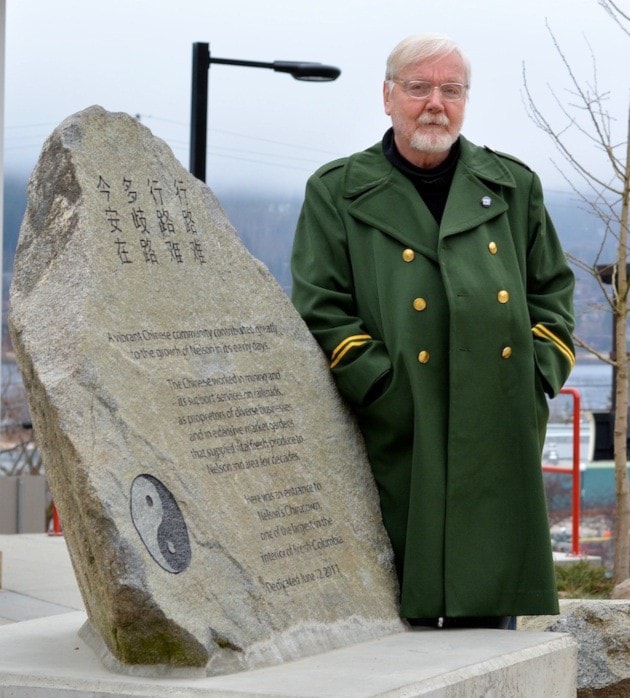The provincial government has recognized Nelson’s former Chinatown as a significant historic site and will add it to the BC Register of Historic Places.
A century ago the Nelson area had a Chinese population of about 1000, in a general population of 4000. Chinese workers helped build the railway, their market gardens fed the city, and they worked as hired help in many Nelson homes. Yet in 1902 the editor of the Nelson Weekly Miner wrote:
“If the Laurier government wished to act in accordance with the views of almost the entire population of British Columbia, it will prohibit absolutely the immigration of Chinese and arrange to kill off — if any legal way can be divined to accomplish that act — every mother’s son of the almond-eyed pigtail wearer, living at present in any country inhabited by white men. He is a filthy, immoral piece of human machinery, not a man in the sense in which the word is used by civilized peoples. He lives like a dog, contributes nothing towards the up-building of the country and poisons every community in which he locates himself.”
Consistent with that philosophy, when white business people decided they needed the land along Vernon St. that was occupied by Chinese residences and businesses, the Chinese population was forcibly moved to the lower areas of town.
Two separate nominations led to the provincial heritage recognition. Touchstones Nelson nominated the Sing Chong Laundry building now owned by Kootenay Co-op Radio, and Nelson resident Claus Schunke nominated the entire Chinatown, which was in an area bounded by Vernon, Front, Ward, and Hall streets.
In 2011 he organized the creation and installation of the stone plaque at the top of the hill at Hall and Vernon containing an inscription acknowledging the significance of Chinese culture in Nelson’s history. Last summer, when the city began re-building Hall St., he worked with them to have the stone moved up onto the pedestrian bulb-out on Vernon, along with two trees that often appear in Chinese gardens, a magnolia and a ginkgo.
In addition to an English language tribute to the Chinese community, a poem in Chinese reads: Hard is the journey/Hard is the journey/So many turns/Now where am I?
Schunke says he has had plans drawn for a traditional Chinese style gazebo for that site and he proposes to offer to the city at no cost.
Schunke says the provincial recognition is a step in the right direction. But he says Nelson still needs to expand its concept of heritage.
“Usually history and heritage in Nelson means white Anglo-Saxon heritage colonial. The only physical manifestation of heritage are all of these colonial types who incidentally could not have put up all these things without the Chinese.”
Schunke says it is not just about buildings.
“We need to go more deeply into heritage. To me heritage is all the social and mental and artistic and spiritual [aspects] feeding into one social group which is Nelson.”
Referring to city council and its arts and heritage committees, Schunke says, “Heritage means nothing to them. They are doing it by rote. They have these buildings and they keep on pushing these buildings in terms of the tourists, but they are not doing anything.”
He says about half the railway workers in the Kootenays were Chinese, so there is a connection with the newly-refurbished railway station, and adds that there were large Chinese market gardens near the station.
“Since there are no Chinese to be seen on the history website of the tourism infocentre, maybe we could have some historical exhibit there, in connection with the visitor centre — a room connected to the visitor centre which presents something about the history of Nelson. And the Chinese component would have to be strong.”
Touchstones nominated the Sing Chong Laundry building at 308A Hall St. for provincial recognition because it is one of the few remaining Chinatown buildings. Built around 1900, it operated as a laundry until 1965, and its name has been roughly translated as “laundry of infinite achievements.”
Touchstones executive director Leah Best says the recognition of the building is significant because it recognizes diversity.
“Like most museums, we reflect a white, male, middle class point of view in terms of what was collected, and we have very little in our collection from the Chinese community. So it is really important when this high degree of recognition comes down, so people understand there was a Chinese community here.”
In addition to Nelson’s Chinatown, 18 other sites in BC were named in the list of Chinese Canadian historic places. The designation does not confer any protected status or funding.
